As we drove deeper into the Stygian gloom of the underground car park I couldn’t see where we were going and then it dawned on me I was still wearing my sunglasses – numpty. A quick change to my normal ones and I could see a little better although the strength of the lights was not very strong. Mohamed found a parking spot and we tried to find our way out, we tried a number of different doors that indicated staircases but they were all locked. After walking around for a while we found someone who directed us to the only working lift. The queue was long but we eventually go in carefully skirting the man sat on a stool working the buttons.
 Quick change back to sunglasses as we arrived back on the surface and the bright sunshine. In front of me was The Egyptian Museum or as it is more formerly known The Museum of Egyptian Antiquities. The pink imposing building was designed by Marcel Dourgnon a Frenchman who won a competition to design the new building to hold the existing collection of Egyptian artefacts which was being housed in unsuitable premises. The cornerstone was laid in 1897 and the museum officially opened on 15th November 1902.
Quick change back to sunglasses as we arrived back on the surface and the bright sunshine. In front of me was The Egyptian Museum or as it is more formerly known The Museum of Egyptian Antiquities. The pink imposing building was designed by Marcel Dourgnon a Frenchman who won a competition to design the new building to hold the existing collection of Egyptian artefacts which was being housed in unsuitable premises. The cornerstone was laid in 1897 and the museum officially opened on 15th November 1902.
 Mohamed and I made our way through the first layer of security and Mohamed sorted out the tickets, different prices for locals and foreigners but, joy of joys I was also able to buy a ticket to take photographs which pleased me greatly. We were then inundated by ‘guides’ who wanted to charge us to take us around. As they didn’t appear to have much English and I wasn’t sure of how knowledgeable they were I was going to say no to them. I didn’t get a chance as Mohamed firmly sent them on their way and we passed through another layer of security to enter the building.
Mohamed and I made our way through the first layer of security and Mohamed sorted out the tickets, different prices for locals and foreigners but, joy of joys I was also able to buy a ticket to take photographs which pleased me greatly. We were then inundated by ‘guides’ who wanted to charge us to take us around. As they didn’t appear to have much English and I wasn’t sure of how knowledgeable they were I was going to say no to them. I didn’t get a chance as Mohamed firmly sent them on their way and we passed through another layer of security to enter the building.
I’m not sure whether we didn’t see them but there wasn’t a map to guide you or a guidebook so we threw caution to the wind and set out on the adventure of discovery. My initial impression was of noise, disorder, dust, dull light.
It was very busy, there were lots of Egyptian school children in groups throughout the museum, lots of tourist, many part of a group with someone leading the group so sometimes it took a while to get close to an exhibit. There were people everywhere but they soon faded into the background as I lost myself in the wonders that surround me. It takes a little while for the fact that you are surrounded by objects that are thousands of years old from a civilisation that has fascinated people forever.


In the end I just wandered around, there was no rhyme nor reason to the route I took and in one visit I saw a lot but was only really able to take in a small amount. Since my visit I have used the photographs I took and the internet in finding out additional information. I am such a nerd but I have since read a really interesting paper by Dr Pearce Paul Creasman on the Dahshur Boats that I saw at the museum.
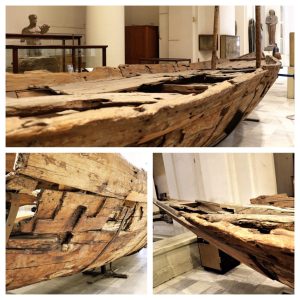 The boat was tucked up near a wall with other displays in front of it. The boat was nearly 4,000 years old and had been discovered in 1894 by the French archaeologist Jean Jacques de Morgan. It was part of the funerary goods of Senusret III and stored in a mud brick pyramid on the plains of Dahshur. The colours and texture of the ancient wood was beautiful and although the boat wasn’t in the best of condition – not surprising considering its age, it is well worth searching it out.
The boat was tucked up near a wall with other displays in front of it. The boat was nearly 4,000 years old and had been discovered in 1894 by the French archaeologist Jean Jacques de Morgan. It was part of the funerary goods of Senusret III and stored in a mud brick pyramid on the plains of Dahshur. The colours and texture of the ancient wood was beautiful and although the boat wasn’t in the best of condition – not surprising considering its age, it is well worth searching it out.

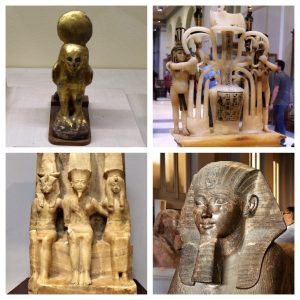
I spent hours just reading about the boat, I imagine that there is a story like that behind each of the exhibits and at present there is approximately 120,000 items stored in the museum so I may be some time. Shame we are not closer to Cairo I could buy a season ticket and take up residence.


I touched stones covered in hieroglyphics that once graced the temple of a pharaoh, I was dwarfed by statues so awesome in their height and grandeur that I stood silently gazing ever upwards at them.
There was a very scary carving of a small child but with adult features which when I think about it may well have been suffering from dwarfism, and a herd of sphinx were scattered in various places. There was also a statue of a lion who reminded me so much of the cowardly lion in the Wizard of Oz.


There were rows of tiny statues of gods and pharaohs in different materials all with tiny hieroglyphics messages/prayers/stories on them. I so wanted to know how to read these symbols so that I knew what each one said.


Many of the items had been damaged, whether this had happened in ancient times or more recently – the museum has been attacked a number of times during revolutions. But this doesn’t detract from the beauty or their impact.
I fell in love with the sycamore statue which may be of the Egyptian scribe and priest called Ka-aper. He has the kindest eyes, the effect of which I am sure is enhanced because they are inlaid with rock crystal, white quartz and resin.


I learnt that true pyramids as opposed to step pyramids were topped by a pyramidion or capstone and the museum has one that was discovered in 1900. It was found in the rubble of the Pyramid of Amenemhet III in Dahshur which was built on unstable ground and began to crumble and was abandoned before completion. On one side of the pyramidion there is carved what looks like a winged sun with a pair of eyes looking outwards, altogether it resembles a face. If this was to be at the very top of a pyramid I wonder what the significance of the eyes looking outwards into the sun.
Since my trip to the museum I have found out the information below.
 David P Silverman the Egyptologist in his book Ancient Egypt using the translation of I E S Edwards writes that the inscription below what I thought looked like a face says:
David P Silverman the Egyptologist in his book Ancient Egypt using the translation of I E S Edwards writes that the inscription below what I thought looked like a face says:
“May the face of the king be opened so that he may see the Lord of the Horizon [Harakhte, god of the rising sun] when he crosses the sky; may he cause the king to shine as a god, lord of eternity and indestructible.”
In reply, Harakhte says he has: “given the fair horizon to the king.”
A prayer to the gods for the reincarnation of the pyramid’s occupant(s) to achieve divine status perhaps.
 Near to the pyramidion is sarcophagus of Pharaoh Merneptah, Ramses II‘s son, inside the lid is a bas-relief of Nut, the Goddess of the Sky. She is covered in stars and is often seen balancing on her toes and finger tips arching over the earth. She is also a symbol of protection for the dead once they enter the afterlife. The relief is seen as a reflection in a mirror set into the floor and it has an other worldly feel to it.
Near to the pyramidion is sarcophagus of Pharaoh Merneptah, Ramses II‘s son, inside the lid is a bas-relief of Nut, the Goddess of the Sky. She is covered in stars and is often seen balancing on her toes and finger tips arching over the earth. She is also a symbol of protection for the dead once they enter the afterlife. The relief is seen as a reflection in a mirror set into the floor and it has an other worldly feel to it.
I could go on writing about what I saw but I am sure that you would soon get fed up with ramblings so I will try to bring this to a suitable end. The museum is chaotic, badly labelled if at all, dusty and closely resembling a storage warehouse but, it is full of the most amazing treasures if you take the time to wander. I desperately want to go back again already.


The only part I wouldn’t go back to was the Royal Mummy exhibition. I’m not sure if it is because it was a fairly small space or how closely you could get to the mummies but the longer I spent in the room the more uncomfortable I became. I wanted to cover them back up and put them back where they belonged and not on show. I was very surprised at the strength of my reaction as I have seen mummies before and even now a few weeks later I still can’t explain my reaction.

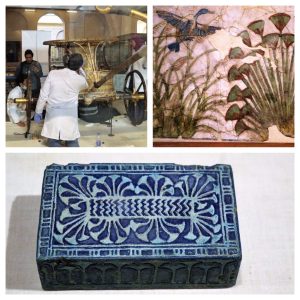
I gather the reason for the chaotic feel to the place is that a new museum the ‘Grand Egyptian Museum’ (GEM) is being built and most of the exhibits will be moved there. The competition for the design was held in 2002 and due to the changing political climate, it’s building was delayed but earthworks started a few years ago and the latest information I can find is that it will be partially opened in 2018 but who knows. I have read reports that the collapse of tourism has also affected the building schedule but hopefully it will be completed soon.
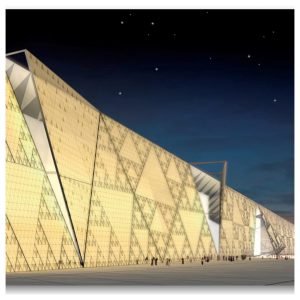
I’ve just realised I haven’t mentioned any of the Tutankhamen artefacts, there really isn’t anything more I can add to the millions of words already written about them. Suffice to say they are spectacular and days could be spent just marvelling at the intricacies of the decoration, construction and beauty of each item.
I think it is obvious that the Egyptian Museum in Cairo is going to end up near the top of the list of places I have fallen in love with.
If you have enjoyed this blog you may want to read the blogs I kept when I lived in Vietnam and Costa Rica.


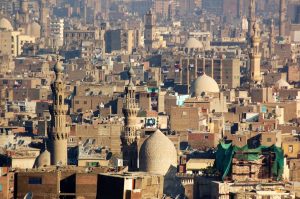 We’re on our way up to Cairo for ML to meet up with other members of the team and to finalise paperwork before a meeting with the Client.
We’re on our way up to Cairo for ML to meet up with other members of the team and to finalise paperwork before a meeting with the Client. ML has stayed with this hotel group so often that we get put on the executive floor which is very nice and included a welcome gift of tiny macarons artfully displayed on a plate. Very swish, and unlike the hotel on the Red Sea there is no sound, it must have very good soundproofing. The wi-fi is super-fast and between us we are soon updating various iPads and iPhones in a fraction of the time it normally takes us and not eating into our mobile download total.
ML has stayed with this hotel group so often that we get put on the executive floor which is very nice and included a welcome gift of tiny macarons artfully displayed on a plate. Very swish, and unlike the hotel on the Red Sea there is no sound, it must have very good soundproofing. The wi-fi is super-fast and between us we are soon updating various iPads and iPhones in a fraction of the time it normally takes us and not eating into our mobile download total. When will I learn, the next morning as 9.45 ticked by ML received a phone call to say the car was being swapped and the driver would be another hour. I hate waiting it is so boring so I walked around the hotel’s main floor only to walk into some sort of promotion for Coca Cola. Lots of corporate people in lanyards and sunglasses posing nonchalantly in the sunshine. There was a huge screen set up outside with Coca Cola branding around it. There were lots of white draped tables set out in front of the screen. I had a look to see if I could see any promotional t-shirts or lanyards but I was out of luck.
When will I learn, the next morning as 9.45 ticked by ML received a phone call to say the car was being swapped and the driver would be another hour. I hate waiting it is so boring so I walked around the hotel’s main floor only to walk into some sort of promotion for Coca Cola. Lots of corporate people in lanyards and sunglasses posing nonchalantly in the sunshine. There was a huge screen set up outside with Coca Cola branding around it. There were lots of white draped tables set out in front of the screen. I had a look to see if I could see any promotional t-shirts or lanyards but I was out of luck.



 The square became a focal point of the Revolution in 2011 when political demonstrations were held. In 2013 over a two-day period millions of Egyptians protested across Egypt including in Tahrir Square. Three days later, General Abdul Fatah al-Sisi announced that President Mohamed Morsi had been removed. A country with a long history of revolution.
The square became a focal point of the Revolution in 2011 when political demonstrations were held. In 2013 over a two-day period millions of Egyptians protested across Egypt including in Tahrir Square. Three days later, General Abdul Fatah al-Sisi announced that President Mohamed Morsi had been removed. A country with a long history of revolution.